Business Finance: Working Capital Management and Capital Budgeting
VerifiedAdded on 2021/04/19
|16
|3690
|161
Report
AI Summary
This report provides a comprehensive analysis of working capital management and capital budgeting techniques in business finance. It begins with an executive summary outlining the key concepts discussed, including the difference between profit and cash flow, the impact of working capital on...
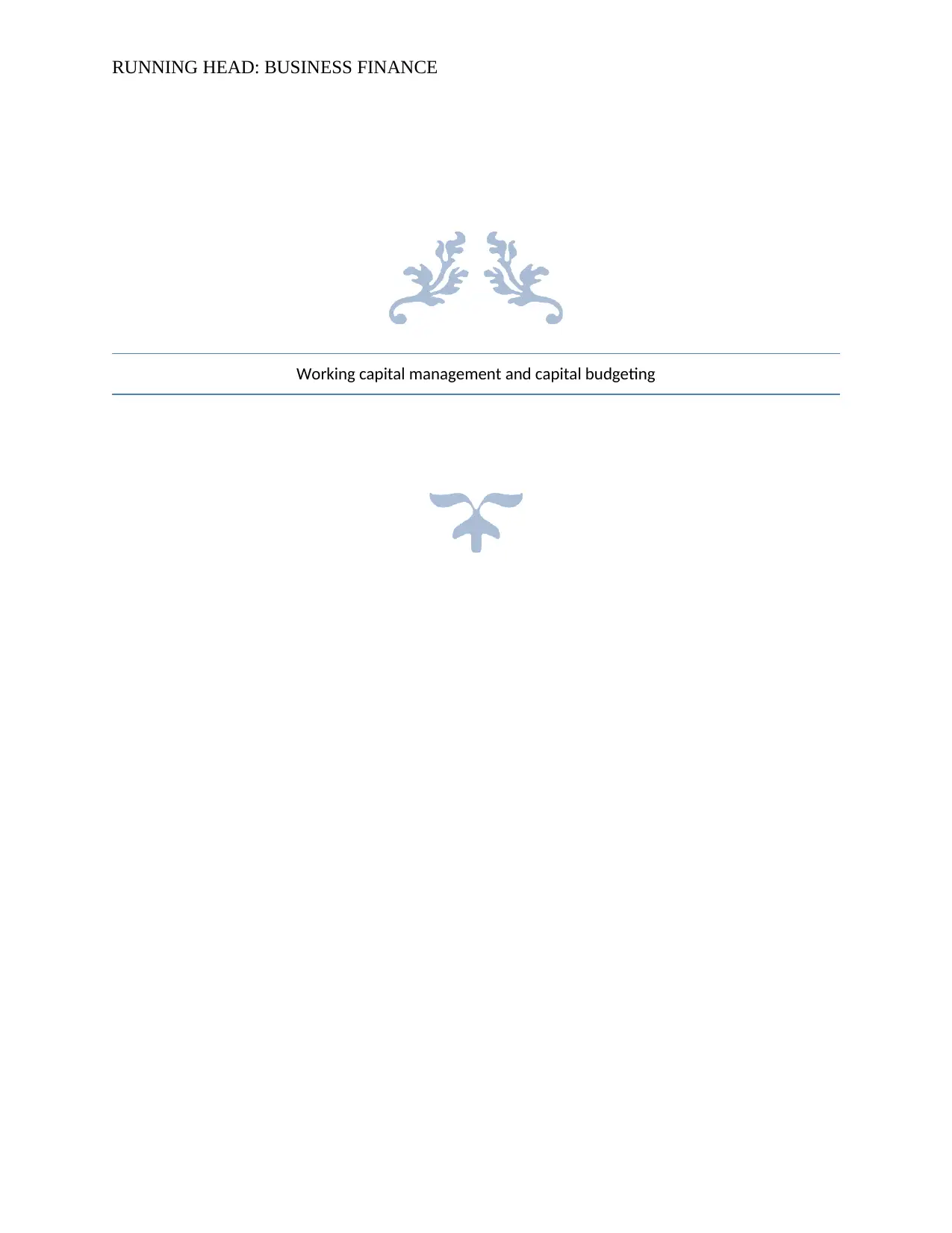
RUNNING HEAD: BUSINESS FINANCE
Working capital management and capital budgeting
Working capital management and capital budgeting
Paraphrase This Document
Need a fresh take? Get an instant paraphrase of this document with our AI Paraphraser
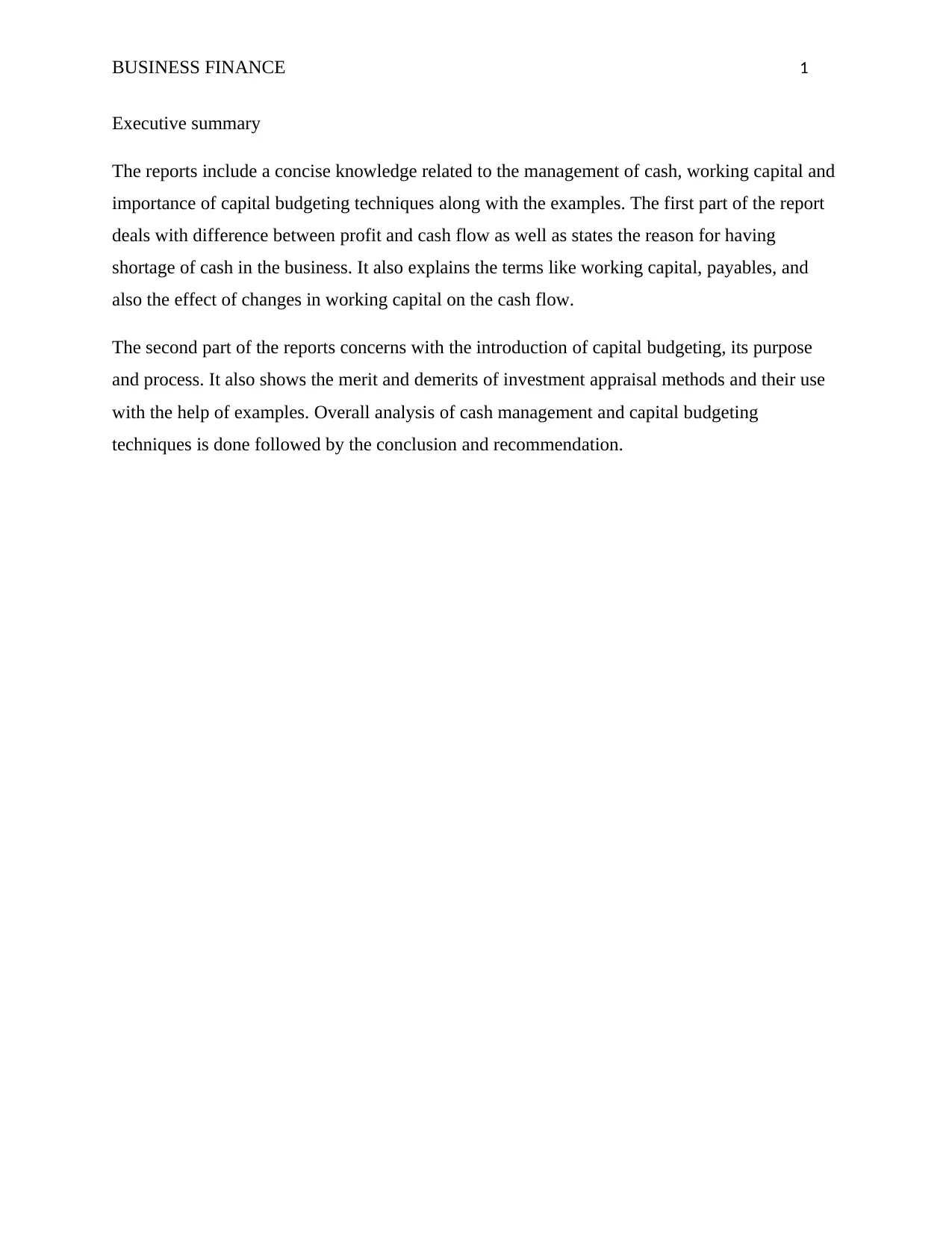
BUSINESS FINANCE 1
Executive summary
The reports include a concise knowledge related to the management of cash, working capital and
importance of capital budgeting techniques along with the examples. The first part of the report
deals with difference between profit and cash flow as well as states the reason for having
shortage of cash in the business. It also explains the terms like working capital, payables, and
also the effect of changes in working capital on the cash flow.
The second part of the reports concerns with the introduction of capital budgeting, its purpose
and process. It also shows the merit and demerits of investment appraisal methods and their use
with the help of examples. Overall analysis of cash management and capital budgeting
techniques is done followed by the conclusion and recommendation.
Executive summary
The reports include a concise knowledge related to the management of cash, working capital and
importance of capital budgeting techniques along with the examples. The first part of the report
deals with difference between profit and cash flow as well as states the reason for having
shortage of cash in the business. It also explains the terms like working capital, payables, and
also the effect of changes in working capital on the cash flow.
The second part of the reports concerns with the introduction of capital budgeting, its purpose
and process. It also shows the merit and demerits of investment appraisal methods and their use
with the help of examples. Overall analysis of cash management and capital budgeting
techniques is done followed by the conclusion and recommendation.
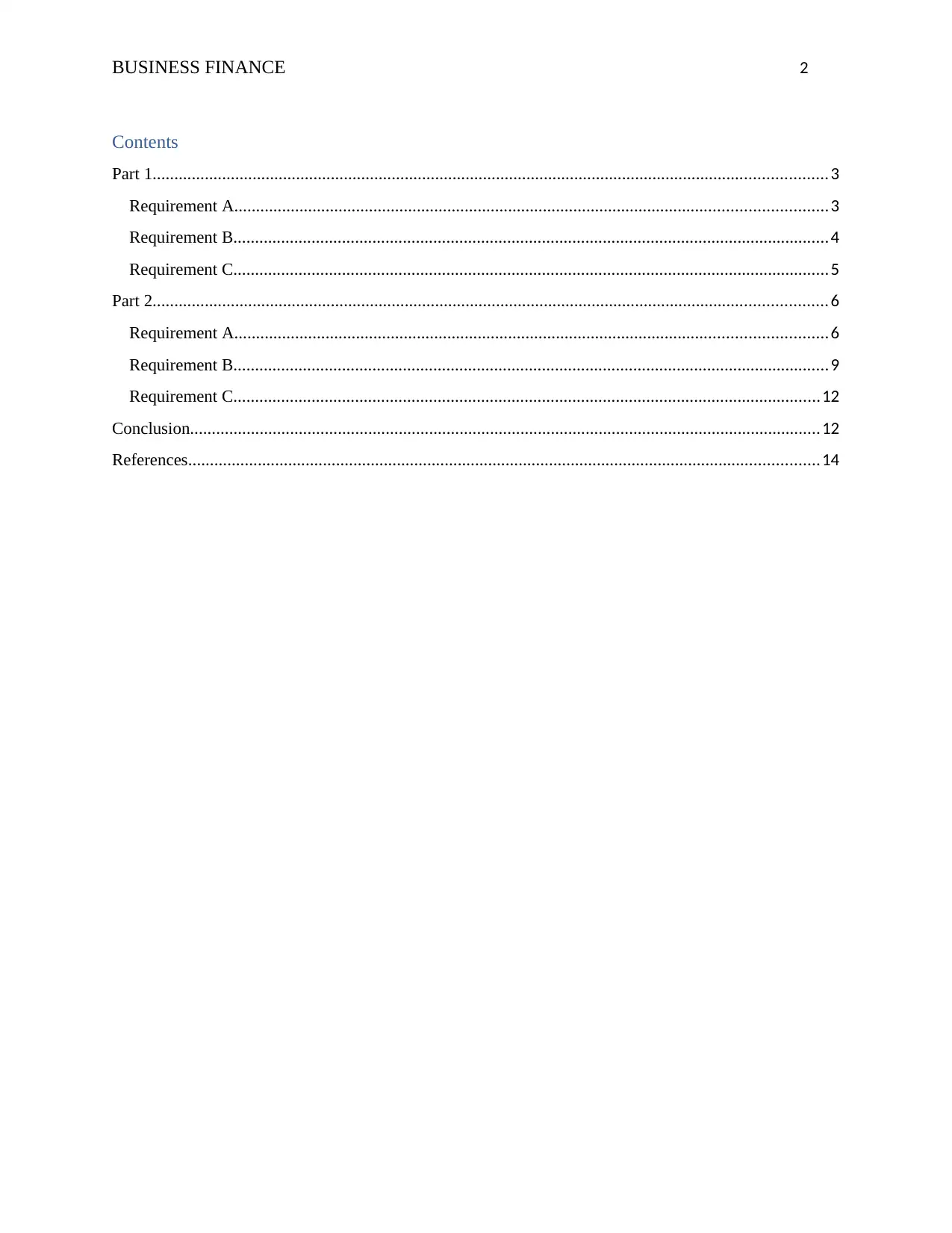
BUSINESS FINANCE 2
Contents
Part 1...........................................................................................................................................................3
Requirement A........................................................................................................................................3
Requirement B.........................................................................................................................................4
Requirement C.........................................................................................................................................5
Part 2...........................................................................................................................................................6
Requirement A........................................................................................................................................6
Requirement B.........................................................................................................................................9
Requirement C.......................................................................................................................................12
Conclusion.................................................................................................................................................12
References.................................................................................................................................................14
Contents
Part 1...........................................................................................................................................................3
Requirement A........................................................................................................................................3
Requirement B.........................................................................................................................................4
Requirement C.........................................................................................................................................5
Part 2...........................................................................................................................................................6
Requirement A........................................................................................................................................6
Requirement B.........................................................................................................................................9
Requirement C.......................................................................................................................................12
Conclusion.................................................................................................................................................12
References.................................................................................................................................................14
⊘ This is a preview!⊘
Do you want full access?
Subscribe today to unlock all pages.

Trusted by 1+ million students worldwide

BUSINESS FINANCE 3
Part 1
Requirement A
(a) Profit is a surplus left after deducting total expenses from the total revenue earned. When
the liabilities of a company reduce and its assets and sales increase, the company earns
profit (Maheshwari, Maheshwari and Maheswari, 2013).
Cash flow is the amount of cash flowing in and out of the business. When the cash
increases it is known as cash inflow and when it decreases, it is considered as cash
outflow (Jury, 2012).
Difference between these two is as follows:
Profit Cash flow
The amount earned from the sales of units. The in and out flow of cash in the business.
The surplus made after paying all the
expenses.
Determines the cash availability for making
various payments.
Accrual basis is taken for preparing the
profit and loss statement
Cash basis is taken for preparing cash flow
statement.
Reflects the profitability of the company. Reflects company’s liquidity and solvency.
An amount generated by subtracting total
expenditure from total income.
A flow of cash in operating, financing and
investing activities of the business.
(b) A capital required for the daily operations of a business is known as working capital. It is
calculated by deducting current assets from current liabilities. In other words, it is defined
as the funds available with the firm for its day to day operations (Sagner, 2010).
Receivables are basically the debtors of a company, to whom the products and services
are provided on credit basis. They are the part of firm’s current assets and are required to
pay back the amount given on credit within a specific period of time (Gilbertson, Lehman
and Harmon, 2013).
Payables are known as creditors of the business, from whom the company purchases
goods and services on credit. They are the current liabilities of the company who get a
desirable amount in return for lending their products and services (Saudagaran, 2009).
Inventory is also a part of company’s current assets. It means the stock or the items hold
by the firm for the purpose of resale. It includes those items which are to be converted
Part 1
Requirement A
(a) Profit is a surplus left after deducting total expenses from the total revenue earned. When
the liabilities of a company reduce and its assets and sales increase, the company earns
profit (Maheshwari, Maheshwari and Maheswari, 2013).
Cash flow is the amount of cash flowing in and out of the business. When the cash
increases it is known as cash inflow and when it decreases, it is considered as cash
outflow (Jury, 2012).
Difference between these two is as follows:
Profit Cash flow
The amount earned from the sales of units. The in and out flow of cash in the business.
The surplus made after paying all the
expenses.
Determines the cash availability for making
various payments.
Accrual basis is taken for preparing the
profit and loss statement
Cash basis is taken for preparing cash flow
statement.
Reflects the profitability of the company. Reflects company’s liquidity and solvency.
An amount generated by subtracting total
expenditure from total income.
A flow of cash in operating, financing and
investing activities of the business.
(b) A capital required for the daily operations of a business is known as working capital. It is
calculated by deducting current assets from current liabilities. In other words, it is defined
as the funds available with the firm for its day to day operations (Sagner, 2010).
Receivables are basically the debtors of a company, to whom the products and services
are provided on credit basis. They are the part of firm’s current assets and are required to
pay back the amount given on credit within a specific period of time (Gilbertson, Lehman
and Harmon, 2013).
Payables are known as creditors of the business, from whom the company purchases
goods and services on credit. They are the current liabilities of the company who get a
desirable amount in return for lending their products and services (Saudagaran, 2009).
Inventory is also a part of company’s current assets. It means the stock or the items hold
by the firm for the purpose of resale. It includes those items which are to be converted
Paraphrase This Document
Need a fresh take? Get an instant paraphrase of this document with our AI Paraphraser

BUSINESS FINANCE 4
into cash within one year. The inventory mainly comprises of raw materials, work in
progress and finished goods (Muller, 2011).
The cash flow of the firm is directly affected by the changes in working capital. Increase in
capital implies that the current assets have risen through investing the resources, which
ultimately reduces the cash flow in the business. On the other hand, decrease in the capital means
current liabilities have raised which reflects that there is an inflow of cash in the business.
Therefore, it can be said that working capital does affect the cash flow of the company and it is
very necessary to analyze the changes in working capital while making the cash flow statement
(Faulkender, et al., 2012).
Requirement B
Root & Cook Ltd
Cash Flow Statement Amount (£’000)
A Cash flow from Operating activities
Cash collected from customers 50000
Cash payment made -30000
Increase/Decrease in Working Capital
Increase in Creditors 12000
Increase in Debtors -8000
Cash flow from Operating activities 24000
B Cash flow from Investing activities
Sale of an asset 5000
Investment -10000
Cash used in investing activities -5000
C Cash flow from Financing activities
Loan repayment -60000
Borrowings 37000
Cash used in Financing activities -23000
Net decrease in cash -4000
The above figures taken are hypothetical. It shows that the liquidity position of the company is
not stable as it does not have enough cash to repay its financial obligations, irrespective of the
fact that it earns profit. Though the increase in creditors makes the inflow of cash but also rise in
debtors implies that the company is not collecting its receivables timely and the cash is flowing
into cash within one year. The inventory mainly comprises of raw materials, work in
progress and finished goods (Muller, 2011).
The cash flow of the firm is directly affected by the changes in working capital. Increase in
capital implies that the current assets have risen through investing the resources, which
ultimately reduces the cash flow in the business. On the other hand, decrease in the capital means
current liabilities have raised which reflects that there is an inflow of cash in the business.
Therefore, it can be said that working capital does affect the cash flow of the company and it is
very necessary to analyze the changes in working capital while making the cash flow statement
(Faulkender, et al., 2012).
Requirement B
Root & Cook Ltd
Cash Flow Statement Amount (£’000)
A Cash flow from Operating activities
Cash collected from customers 50000
Cash payment made -30000
Increase/Decrease in Working Capital
Increase in Creditors 12000
Increase in Debtors -8000
Cash flow from Operating activities 24000
B Cash flow from Investing activities
Sale of an asset 5000
Investment -10000
Cash used in investing activities -5000
C Cash flow from Financing activities
Loan repayment -60000
Borrowings 37000
Cash used in Financing activities -23000
Net decrease in cash -4000
The above figures taken are hypothetical. It shows that the liquidity position of the company is
not stable as it does not have enough cash to repay its financial obligations, irrespective of the
fact that it earns profit. Though the increase in creditors makes the inflow of cash but also rise in
debtors implies that the company is not collecting its receivables timely and the cash is flowing
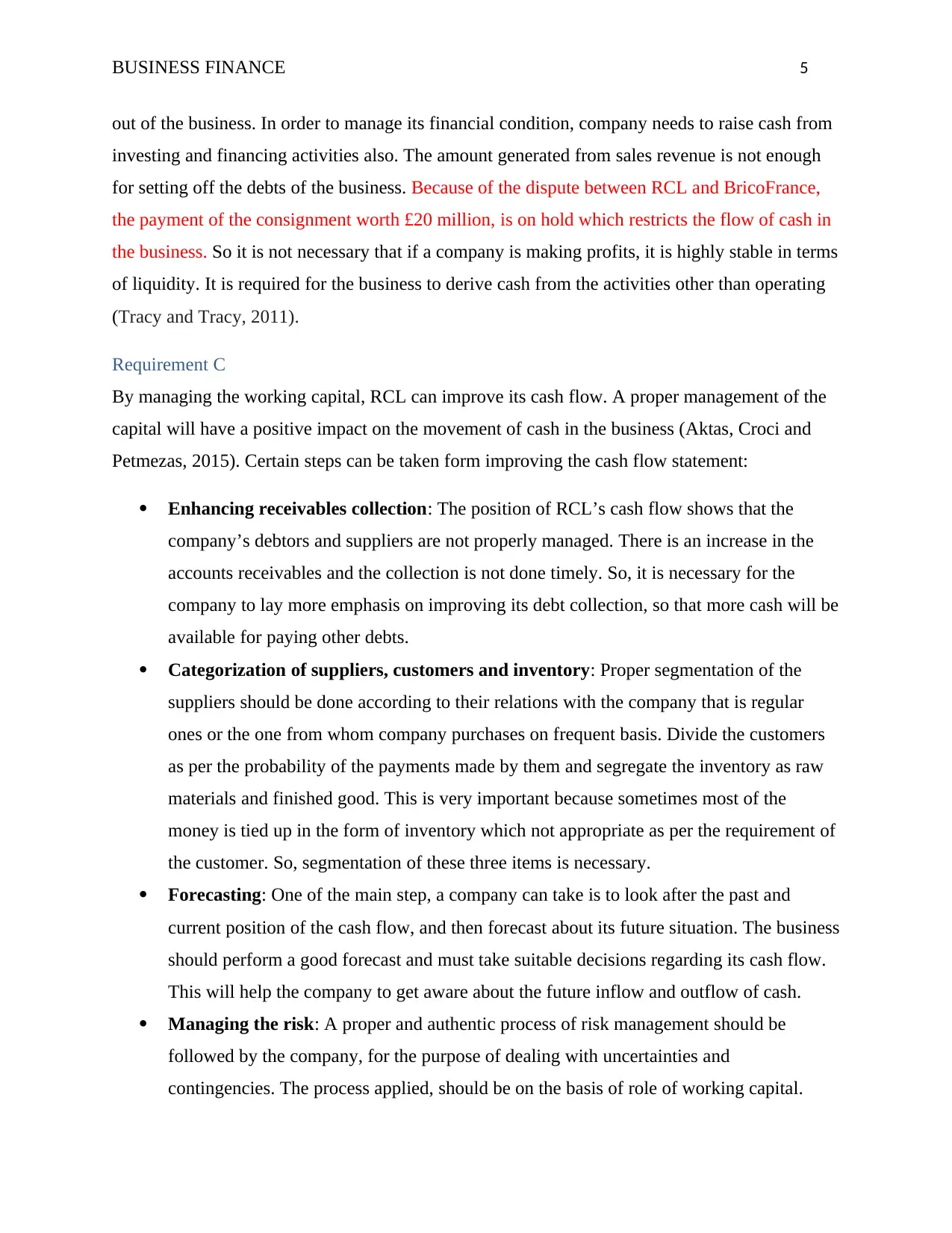
BUSINESS FINANCE 5
out of the business. In order to manage its financial condition, company needs to raise cash from
investing and financing activities also. The amount generated from sales revenue is not enough
for setting off the debts of the business. Because of the dispute between RCL and BricoFrance,
the payment of the consignment worth £20 million, is on hold which restricts the flow of cash in
the business. So it is not necessary that if a company is making profits, it is highly stable in terms
of liquidity. It is required for the business to derive cash from the activities other than operating
(Tracy and Tracy, 2011).
Requirement C
By managing the working capital, RCL can improve its cash flow. A proper management of the
capital will have a positive impact on the movement of cash in the business (Aktas, Croci and
Petmezas, 2015). Certain steps can be taken form improving the cash flow statement:
Enhancing receivables collection: The position of RCL’s cash flow shows that the
company’s debtors and suppliers are not properly managed. There is an increase in the
accounts receivables and the collection is not done timely. So, it is necessary for the
company to lay more emphasis on improving its debt collection, so that more cash will be
available for paying other debts.
Categorization of suppliers, customers and inventory: Proper segmentation of the
suppliers should be done according to their relations with the company that is regular
ones or the one from whom company purchases on frequent basis. Divide the customers
as per the probability of the payments made by them and segregate the inventory as raw
materials and finished good. This is very important because sometimes most of the
money is tied up in the form of inventory which not appropriate as per the requirement of
the customer. So, segmentation of these three items is necessary.
Forecasting: One of the main step, a company can take is to look after the past and
current position of the cash flow, and then forecast about its future situation. The business
should perform a good forecast and must take suitable decisions regarding its cash flow.
This will help the company to get aware about the future inflow and outflow of cash.
Managing the risk: A proper and authentic process of risk management should be
followed by the company, for the purpose of dealing with uncertainties and
contingencies. The process applied, should be on the basis of role of working capital.
out of the business. In order to manage its financial condition, company needs to raise cash from
investing and financing activities also. The amount generated from sales revenue is not enough
for setting off the debts of the business. Because of the dispute between RCL and BricoFrance,
the payment of the consignment worth £20 million, is on hold which restricts the flow of cash in
the business. So it is not necessary that if a company is making profits, it is highly stable in terms
of liquidity. It is required for the business to derive cash from the activities other than operating
(Tracy and Tracy, 2011).
Requirement C
By managing the working capital, RCL can improve its cash flow. A proper management of the
capital will have a positive impact on the movement of cash in the business (Aktas, Croci and
Petmezas, 2015). Certain steps can be taken form improving the cash flow statement:
Enhancing receivables collection: The position of RCL’s cash flow shows that the
company’s debtors and suppliers are not properly managed. There is an increase in the
accounts receivables and the collection is not done timely. So, it is necessary for the
company to lay more emphasis on improving its debt collection, so that more cash will be
available for paying other debts.
Categorization of suppliers, customers and inventory: Proper segmentation of the
suppliers should be done according to their relations with the company that is regular
ones or the one from whom company purchases on frequent basis. Divide the customers
as per the probability of the payments made by them and segregate the inventory as raw
materials and finished good. This is very important because sometimes most of the
money is tied up in the form of inventory which not appropriate as per the requirement of
the customer. So, segmentation of these three items is necessary.
Forecasting: One of the main step, a company can take is to look after the past and
current position of the cash flow, and then forecast about its future situation. The business
should perform a good forecast and must take suitable decisions regarding its cash flow.
This will help the company to get aware about the future inflow and outflow of cash.
Managing the risk: A proper and authentic process of risk management should be
followed by the company, for the purpose of dealing with uncertainties and
contingencies. The process applied, should be on the basis of role of working capital.
⊘ This is a preview!⊘
Do you want full access?
Subscribe today to unlock all pages.

Trusted by 1+ million students worldwide
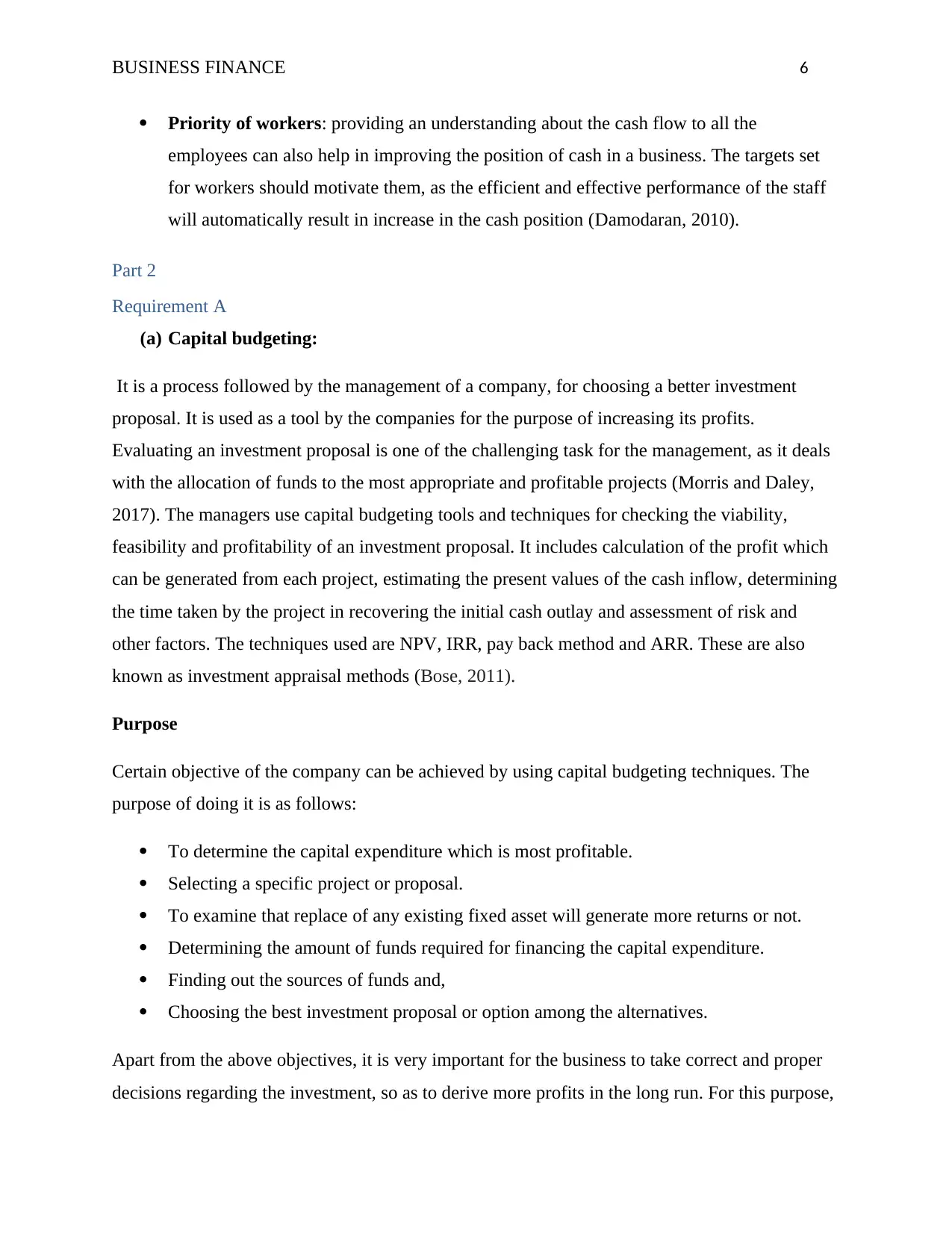
BUSINESS FINANCE 6
Priority of workers: providing an understanding about the cash flow to all the
employees can also help in improving the position of cash in a business. The targets set
for workers should motivate them, as the efficient and effective performance of the staff
will automatically result in increase in the cash position (Damodaran, 2010).
Part 2
Requirement A
(a) Capital budgeting:
It is a process followed by the management of a company, for choosing a better investment
proposal. It is used as a tool by the companies for the purpose of increasing its profits.
Evaluating an investment proposal is one of the challenging task for the management, as it deals
with the allocation of funds to the most appropriate and profitable projects (Morris and Daley,
2017). The managers use capital budgeting tools and techniques for checking the viability,
feasibility and profitability of an investment proposal. It includes calculation of the profit which
can be generated from each project, estimating the present values of the cash inflow, determining
the time taken by the project in recovering the initial cash outlay and assessment of risk and
other factors. The techniques used are NPV, IRR, pay back method and ARR. These are also
known as investment appraisal methods (Bose, 2011).
Purpose
Certain objective of the company can be achieved by using capital budgeting techniques. The
purpose of doing it is as follows:
To determine the capital expenditure which is most profitable.
Selecting a specific project or proposal.
To examine that replace of any existing fixed asset will generate more returns or not.
Determining the amount of funds required for financing the capital expenditure.
Finding out the sources of funds and,
Choosing the best investment proposal or option among the alternatives.
Apart from the above objectives, it is very important for the business to take correct and proper
decisions regarding the investment, so as to derive more profits in the long run. For this purpose,
Priority of workers: providing an understanding about the cash flow to all the
employees can also help in improving the position of cash in a business. The targets set
for workers should motivate them, as the efficient and effective performance of the staff
will automatically result in increase in the cash position (Damodaran, 2010).
Part 2
Requirement A
(a) Capital budgeting:
It is a process followed by the management of a company, for choosing a better investment
proposal. It is used as a tool by the companies for the purpose of increasing its profits.
Evaluating an investment proposal is one of the challenging task for the management, as it deals
with the allocation of funds to the most appropriate and profitable projects (Morris and Daley,
2017). The managers use capital budgeting tools and techniques for checking the viability,
feasibility and profitability of an investment proposal. It includes calculation of the profit which
can be generated from each project, estimating the present values of the cash inflow, determining
the time taken by the project in recovering the initial cash outlay and assessment of risk and
other factors. The techniques used are NPV, IRR, pay back method and ARR. These are also
known as investment appraisal methods (Bose, 2011).
Purpose
Certain objective of the company can be achieved by using capital budgeting techniques. The
purpose of doing it is as follows:
To determine the capital expenditure which is most profitable.
Selecting a specific project or proposal.
To examine that replace of any existing fixed asset will generate more returns or not.
Determining the amount of funds required for financing the capital expenditure.
Finding out the sources of funds and,
Choosing the best investment proposal or option among the alternatives.
Apart from the above objectives, it is very important for the business to take correct and proper
decisions regarding the investment, so as to derive more profits in the long run. For this purpose,
Paraphrase This Document
Need a fresh take? Get an instant paraphrase of this document with our AI Paraphraser
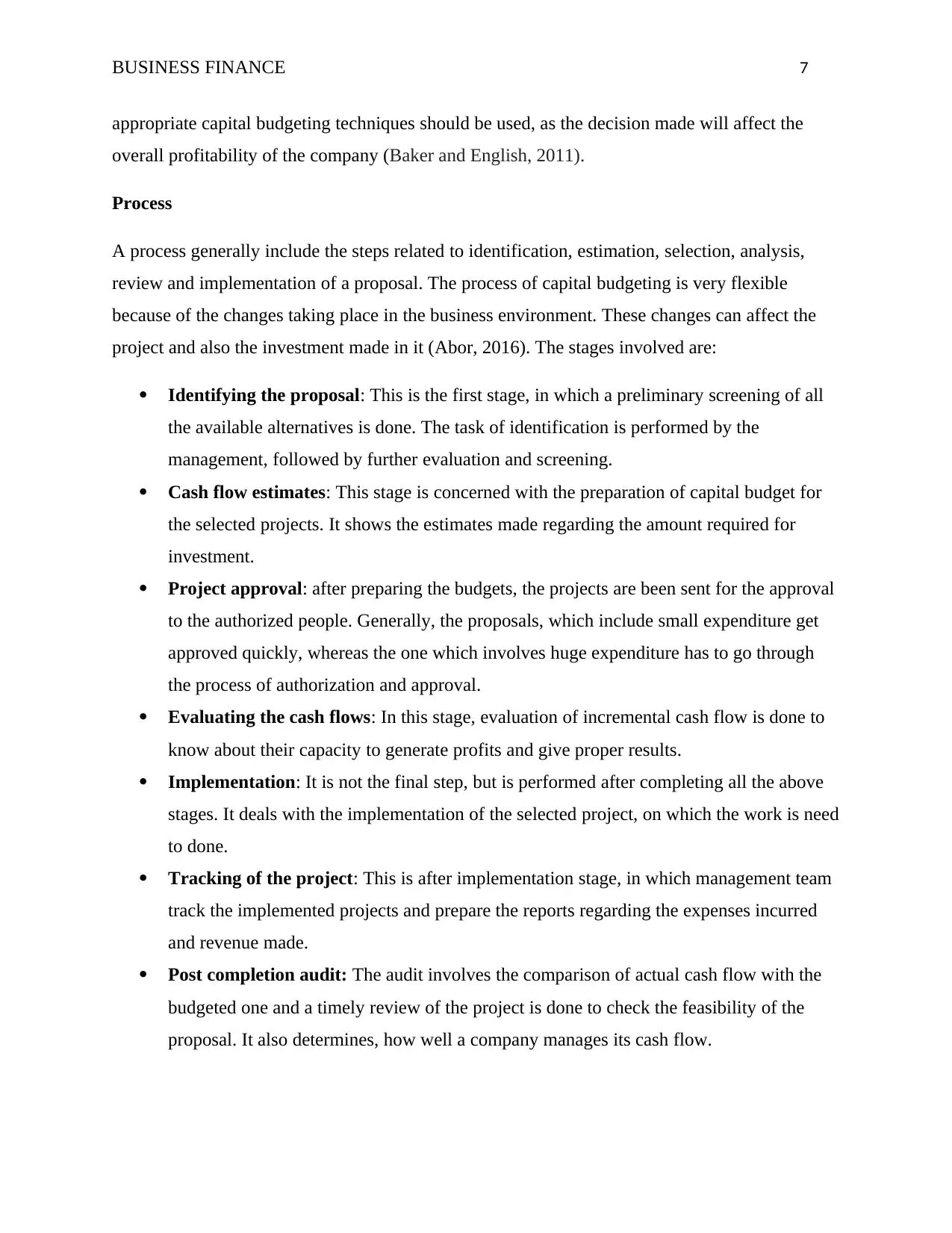
BUSINESS FINANCE 7
appropriate capital budgeting techniques should be used, as the decision made will affect the
overall profitability of the company (Baker and English, 2011).
Process
A process generally include the steps related to identification, estimation, selection, analysis,
review and implementation of a proposal. The process of capital budgeting is very flexible
because of the changes taking place in the business environment. These changes can affect the
project and also the investment made in it (Abor, 2016). The stages involved are:
Identifying the proposal: This is the first stage, in which a preliminary screening of all
the available alternatives is done. The task of identification is performed by the
management, followed by further evaluation and screening.
Cash flow estimates: This stage is concerned with the preparation of capital budget for
the selected projects. It shows the estimates made regarding the amount required for
investment.
Project approval: after preparing the budgets, the projects are been sent for the approval
to the authorized people. Generally, the proposals, which include small expenditure get
approved quickly, whereas the one which involves huge expenditure has to go through
the process of authorization and approval.
Evaluating the cash flows: In this stage, evaluation of incremental cash flow is done to
know about their capacity to generate profits and give proper results.
Implementation: It is not the final step, but is performed after completing all the above
stages. It deals with the implementation of the selected project, on which the work is need
to done.
Tracking of the project: This is after implementation stage, in which management team
track the implemented projects and prepare the reports regarding the expenses incurred
and revenue made.
Post completion audit: The audit involves the comparison of actual cash flow with the
budgeted one and a timely review of the project is done to check the feasibility of the
proposal. It also determines, how well a company manages its cash flow.
appropriate capital budgeting techniques should be used, as the decision made will affect the
overall profitability of the company (Baker and English, 2011).
Process
A process generally include the steps related to identification, estimation, selection, analysis,
review and implementation of a proposal. The process of capital budgeting is very flexible
because of the changes taking place in the business environment. These changes can affect the
project and also the investment made in it (Abor, 2016). The stages involved are:
Identifying the proposal: This is the first stage, in which a preliminary screening of all
the available alternatives is done. The task of identification is performed by the
management, followed by further evaluation and screening.
Cash flow estimates: This stage is concerned with the preparation of capital budget for
the selected projects. It shows the estimates made regarding the amount required for
investment.
Project approval: after preparing the budgets, the projects are been sent for the approval
to the authorized people. Generally, the proposals, which include small expenditure get
approved quickly, whereas the one which involves huge expenditure has to go through
the process of authorization and approval.
Evaluating the cash flows: In this stage, evaluation of incremental cash flow is done to
know about their capacity to generate profits and give proper results.
Implementation: It is not the final step, but is performed after completing all the above
stages. It deals with the implementation of the selected project, on which the work is need
to done.
Tracking of the project: This is after implementation stage, in which management team
track the implemented projects and prepare the reports regarding the expenses incurred
and revenue made.
Post completion audit: The audit involves the comparison of actual cash flow with the
budgeted one and a timely review of the project is done to check the feasibility of the
proposal. It also determines, how well a company manages its cash flow.
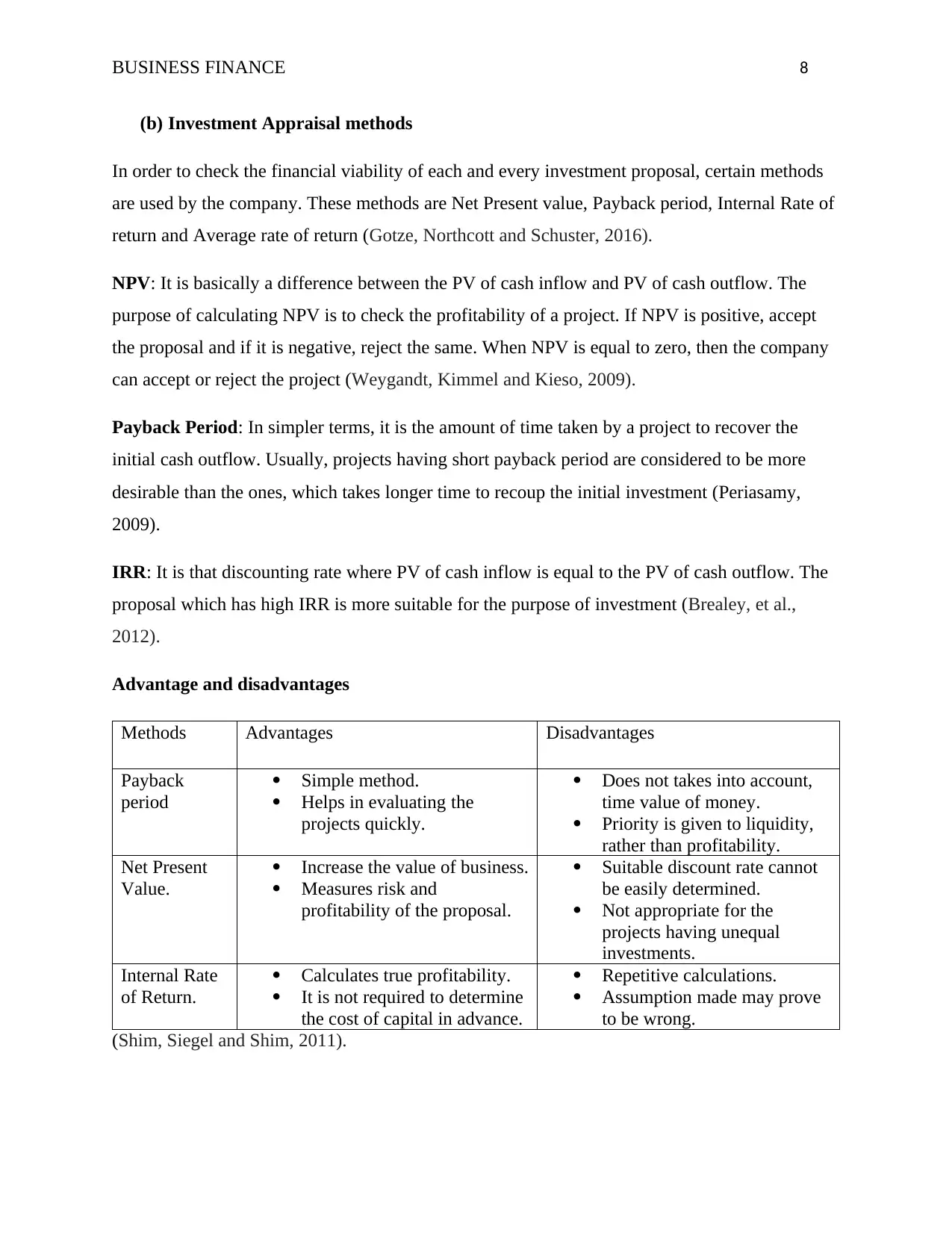
BUSINESS FINANCE 8
(b) Investment Appraisal methods
In order to check the financial viability of each and every investment proposal, certain methods
are used by the company. These methods are Net Present value, Payback period, Internal Rate of
return and Average rate of return (Gotze, Northcott and Schuster, 2016).
NPV: It is basically a difference between the PV of cash inflow and PV of cash outflow. The
purpose of calculating NPV is to check the profitability of a project. If NPV is positive, accept
the proposal and if it is negative, reject the same. When NPV is equal to zero, then the company
can accept or reject the project (Weygandt, Kimmel and Kieso, 2009).
Payback Period: In simpler terms, it is the amount of time taken by a project to recover the
initial cash outflow. Usually, projects having short payback period are considered to be more
desirable than the ones, which takes longer time to recoup the initial investment (Periasamy,
2009).
IRR: It is that discounting rate where PV of cash inflow is equal to the PV of cash outflow. The
proposal which has high IRR is more suitable for the purpose of investment (Brealey, et al.,
2012).
Advantage and disadvantages
Methods Advantages Disadvantages
Payback
period
Simple method.
Helps in evaluating the
projects quickly.
Does not takes into account,
time value of money.
Priority is given to liquidity,
rather than profitability.
Net Present
Value.
Increase the value of business.
Measures risk and
profitability of the proposal.
Suitable discount rate cannot
be easily determined.
Not appropriate for the
projects having unequal
investments.
Internal Rate
of Return.
Calculates true profitability.
It is not required to determine
the cost of capital in advance.
Repetitive calculations.
Assumption made may prove
to be wrong.
(Shim, Siegel and Shim, 2011).
(b) Investment Appraisal methods
In order to check the financial viability of each and every investment proposal, certain methods
are used by the company. These methods are Net Present value, Payback period, Internal Rate of
return and Average rate of return (Gotze, Northcott and Schuster, 2016).
NPV: It is basically a difference between the PV of cash inflow and PV of cash outflow. The
purpose of calculating NPV is to check the profitability of a project. If NPV is positive, accept
the proposal and if it is negative, reject the same. When NPV is equal to zero, then the company
can accept or reject the project (Weygandt, Kimmel and Kieso, 2009).
Payback Period: In simpler terms, it is the amount of time taken by a project to recover the
initial cash outflow. Usually, projects having short payback period are considered to be more
desirable than the ones, which takes longer time to recoup the initial investment (Periasamy,
2009).
IRR: It is that discounting rate where PV of cash inflow is equal to the PV of cash outflow. The
proposal which has high IRR is more suitable for the purpose of investment (Brealey, et al.,
2012).
Advantage and disadvantages
Methods Advantages Disadvantages
Payback
period
Simple method.
Helps in evaluating the
projects quickly.
Does not takes into account,
time value of money.
Priority is given to liquidity,
rather than profitability.
Net Present
Value.
Increase the value of business.
Measures risk and
profitability of the proposal.
Suitable discount rate cannot
be easily determined.
Not appropriate for the
projects having unequal
investments.
Internal Rate
of Return.
Calculates true profitability.
It is not required to determine
the cost of capital in advance.
Repetitive calculations.
Assumption made may prove
to be wrong.
(Shim, Siegel and Shim, 2011).
⊘ This is a preview!⊘
Do you want full access?
Subscribe today to unlock all pages.

Trusted by 1+ million students worldwide
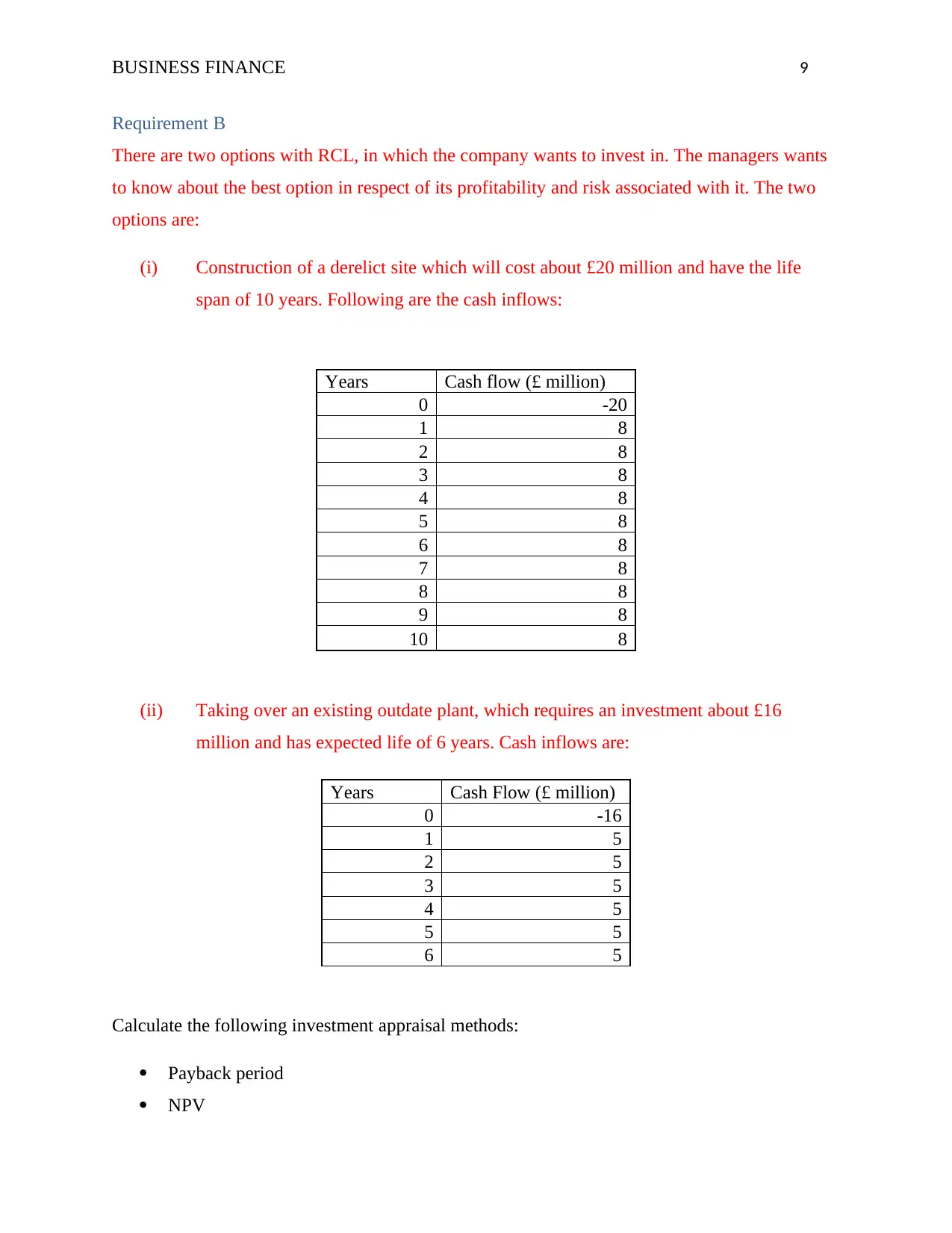
BUSINESS FINANCE 9
Requirement B
There are two options with RCL, in which the company wants to invest in. The managers wants
to know about the best option in respect of its profitability and risk associated with it. The two
options are:
(i) Construction of a derelict site which will cost about £20 million and have the life
span of 10 years. Following are the cash inflows:
Years Cash flow (£ million)
0 -20
1 8
2 8
3 8
4 8
5 8
6 8
7 8
8 8
9 8
10 8
(ii) Taking over an existing outdate plant, which requires an investment about £16
million and has expected life of 6 years. Cash inflows are:
Years Cash Flow (£ million)
0 -16
1 5
2 5
3 5
4 5
5 5
6 5
Calculate the following investment appraisal methods:
Payback period
NPV
Requirement B
There are two options with RCL, in which the company wants to invest in. The managers wants
to know about the best option in respect of its profitability and risk associated with it. The two
options are:
(i) Construction of a derelict site which will cost about £20 million and have the life
span of 10 years. Following are the cash inflows:
Years Cash flow (£ million)
0 -20
1 8
2 8
3 8
4 8
5 8
6 8
7 8
8 8
9 8
10 8
(ii) Taking over an existing outdate plant, which requires an investment about £16
million and has expected life of 6 years. Cash inflows are:
Years Cash Flow (£ million)
0 -16
1 5
2 5
3 5
4 5
5 5
6 5
Calculate the following investment appraisal methods:
Payback period
NPV
Paraphrase This Document
Need a fresh take? Get an instant paraphrase of this document with our AI Paraphraser
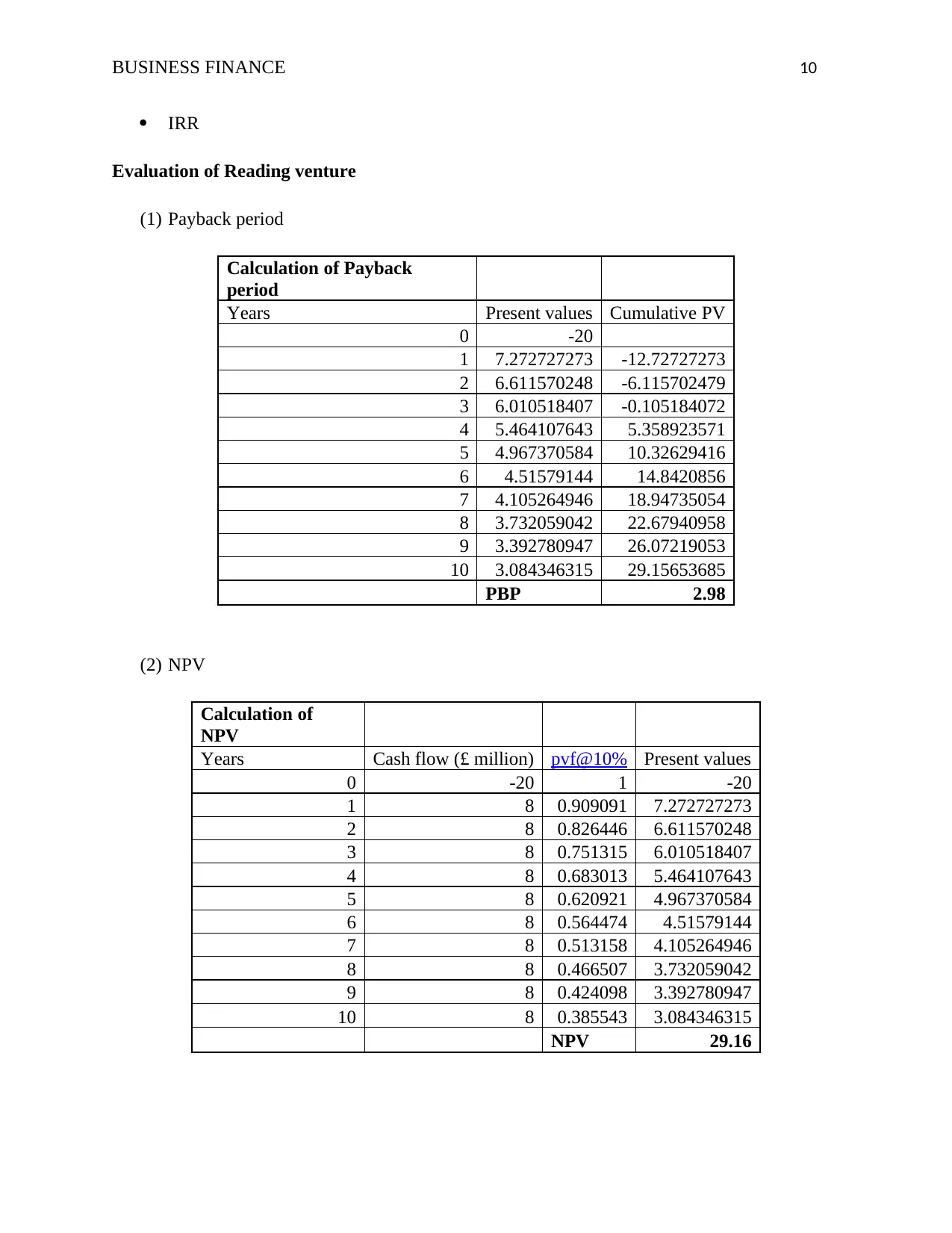
BUSINESS FINANCE 10
IRR
Evaluation of Reading venture
(1) Payback period
Calculation of Payback
period
Years Present values Cumulative PV
0 -20
1 7.272727273 -12.72727273
2 6.611570248 -6.115702479
3 6.010518407 -0.105184072
4 5.464107643 5.358923571
5 4.967370584 10.32629416
6 4.51579144 14.8420856
7 4.105264946 18.94735054
8 3.732059042 22.67940958
9 3.392780947 26.07219053
10 3.084346315 29.15653685
PBP 2.98
(2) NPV
Calculation of
NPV
Years Cash flow (£ million) pvf@10% Present values
0 -20 1 -20
1 8 0.909091 7.272727273
2 8 0.826446 6.611570248
3 8 0.751315 6.010518407
4 8 0.683013 5.464107643
5 8 0.620921 4.967370584
6 8 0.564474 4.51579144
7 8 0.513158 4.105264946
8 8 0.466507 3.732059042
9 8 0.424098 3.392780947
10 8 0.385543 3.084346315
NPV 29.16
IRR
Evaluation of Reading venture
(1) Payback period
Calculation of Payback
period
Years Present values Cumulative PV
0 -20
1 7.272727273 -12.72727273
2 6.611570248 -6.115702479
3 6.010518407 -0.105184072
4 5.464107643 5.358923571
5 4.967370584 10.32629416
6 4.51579144 14.8420856
7 4.105264946 18.94735054
8 3.732059042 22.67940958
9 3.392780947 26.07219053
10 3.084346315 29.15653685
PBP 2.98
(2) NPV
Calculation of
NPV
Years Cash flow (£ million) pvf@10% Present values
0 -20 1 -20
1 8 0.909091 7.272727273
2 8 0.826446 6.611570248
3 8 0.751315 6.010518407
4 8 0.683013 5.464107643
5 8 0.620921 4.967370584
6 8 0.564474 4.51579144
7 8 0.513158 4.105264946
8 8 0.466507 3.732059042
9 8 0.424098 3.392780947
10 8 0.385543 3.084346315
NPV 29.16

BUSINESS FINANCE 11
(3) IRR
Calculation of
IRR
Years Cash flow (£ million)
0 -20
1 8
2 8
3 8
4 8
5 8
6 8
7 8
8 8
9 8
10 8
IRR 38%
Evaluation of Bristol venture
(1) Payback period
Calculation of Payback
period
Years Present values Cumulative PV
0 -16
1 4.545454545 -11.45454545
2 4.132231405 -7.32231405
3 3.756574005 -3.565740045
4 3.415067277 -0.150672768
5 3.104606615 2.953933847
6 2.82236965 5.776303497
PBP 3.95
(2) NPV
Calculation of
NPV
Years Cash Flow (£ million) pvf@10% Present values
0 -16 1 -16
(3) IRR
Calculation of
IRR
Years Cash flow (£ million)
0 -20
1 8
2 8
3 8
4 8
5 8
6 8
7 8
8 8
9 8
10 8
IRR 38%
Evaluation of Bristol venture
(1) Payback period
Calculation of Payback
period
Years Present values Cumulative PV
0 -16
1 4.545454545 -11.45454545
2 4.132231405 -7.32231405
3 3.756574005 -3.565740045
4 3.415067277 -0.150672768
5 3.104606615 2.953933847
6 2.82236965 5.776303497
PBP 3.95
(2) NPV
Calculation of
NPV
Years Cash Flow (£ million) pvf@10% Present values
0 -16 1 -16
⊘ This is a preview!⊘
Do you want full access?
Subscribe today to unlock all pages.

Trusted by 1+ million students worldwide
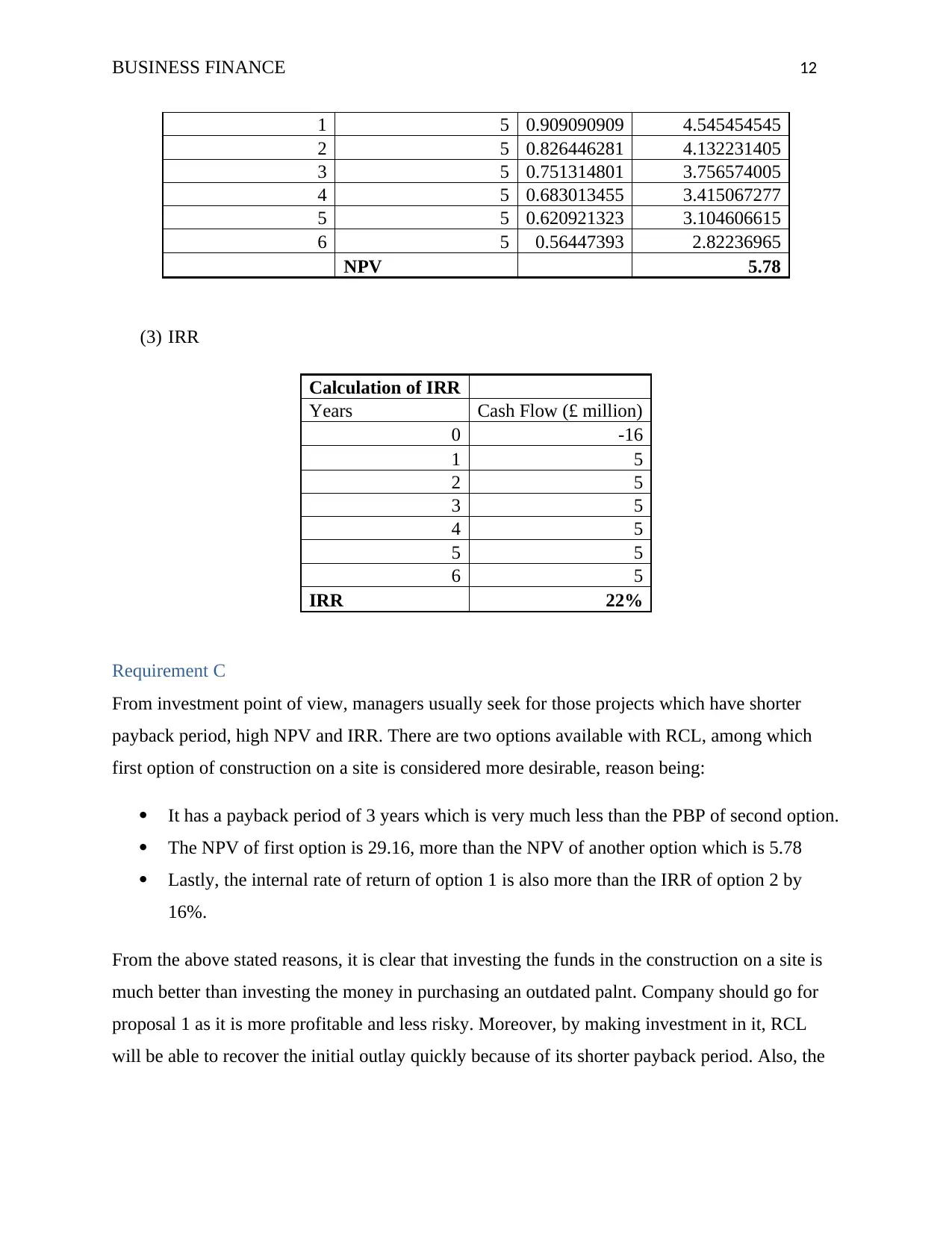
BUSINESS FINANCE 12
1 5 0.909090909 4.545454545
2 5 0.826446281 4.132231405
3 5 0.751314801 3.756574005
4 5 0.683013455 3.415067277
5 5 0.620921323 3.104606615
6 5 0.56447393 2.82236965
NPV 5.78
(3) IRR
Calculation of IRR
Years Cash Flow (£ million)
0 -16
1 5
2 5
3 5
4 5
5 5
6 5
IRR 22%
Requirement C
From investment point of view, managers usually seek for those projects which have shorter
payback period, high NPV and IRR. There are two options available with RCL, among which
first option of construction on a site is considered more desirable, reason being:
It has a payback period of 3 years which is very much less than the PBP of second option.
The NPV of first option is 29.16, more than the NPV of another option which is 5.78
Lastly, the internal rate of return of option 1 is also more than the IRR of option 2 by
16%.
From the above stated reasons, it is clear that investing the funds in the construction on a site is
much better than investing the money in purchasing an outdated palnt. Company should go for
proposal 1 as it is more profitable and less risky. Moreover, by making investment in it, RCL
will be able to recover the initial outlay quickly because of its shorter payback period. Also, the
1 5 0.909090909 4.545454545
2 5 0.826446281 4.132231405
3 5 0.751314801 3.756574005
4 5 0.683013455 3.415067277
5 5 0.620921323 3.104606615
6 5 0.56447393 2.82236965
NPV 5.78
(3) IRR
Calculation of IRR
Years Cash Flow (£ million)
0 -16
1 5
2 5
3 5
4 5
5 5
6 5
IRR 22%
Requirement C
From investment point of view, managers usually seek for those projects which have shorter
payback period, high NPV and IRR. There are two options available with RCL, among which
first option of construction on a site is considered more desirable, reason being:
It has a payback period of 3 years which is very much less than the PBP of second option.
The NPV of first option is 29.16, more than the NPV of another option which is 5.78
Lastly, the internal rate of return of option 1 is also more than the IRR of option 2 by
16%.
From the above stated reasons, it is clear that investing the funds in the construction on a site is
much better than investing the money in purchasing an outdated palnt. Company should go for
proposal 1 as it is more profitable and less risky. Moreover, by making investment in it, RCL
will be able to recover the initial outlay quickly because of its shorter payback period. Also, the
Paraphrase This Document
Need a fresh take? Get an instant paraphrase of this document with our AI Paraphraser
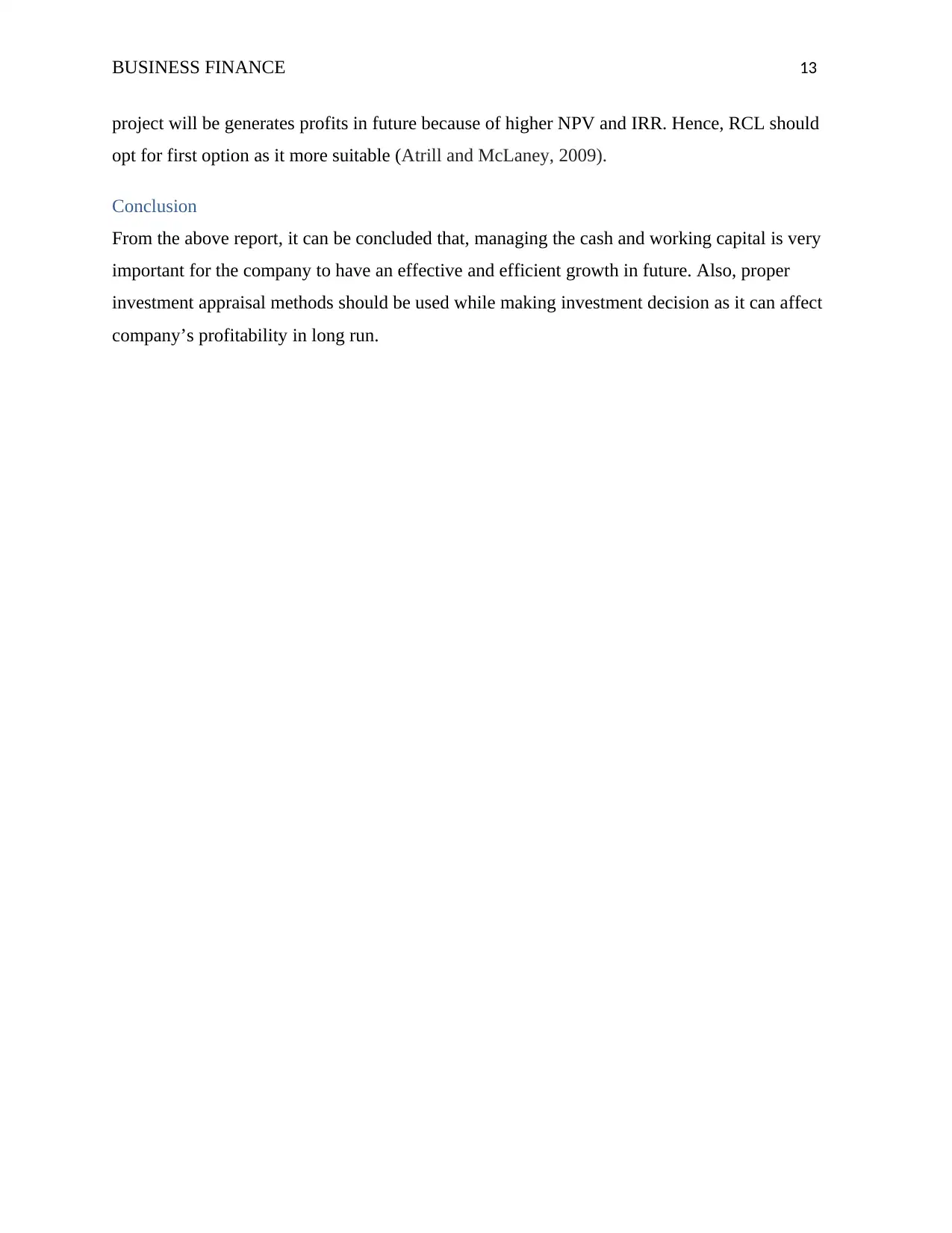
BUSINESS FINANCE 13
project will be generates profits in future because of higher NPV and IRR. Hence, RCL should
opt for first option as it more suitable (Atrill and McLaney, 2009).
Conclusion
From the above report, it can be concluded that, managing the cash and working capital is very
important for the company to have an effective and efficient growth in future. Also, proper
investment appraisal methods should be used while making investment decision as it can affect
company’s profitability in long run.
project will be generates profits in future because of higher NPV and IRR. Hence, RCL should
opt for first option as it more suitable (Atrill and McLaney, 2009).
Conclusion
From the above report, it can be concluded that, managing the cash and working capital is very
important for the company to have an effective and efficient growth in future. Also, proper
investment appraisal methods should be used while making investment decision as it can affect
company’s profitability in long run.
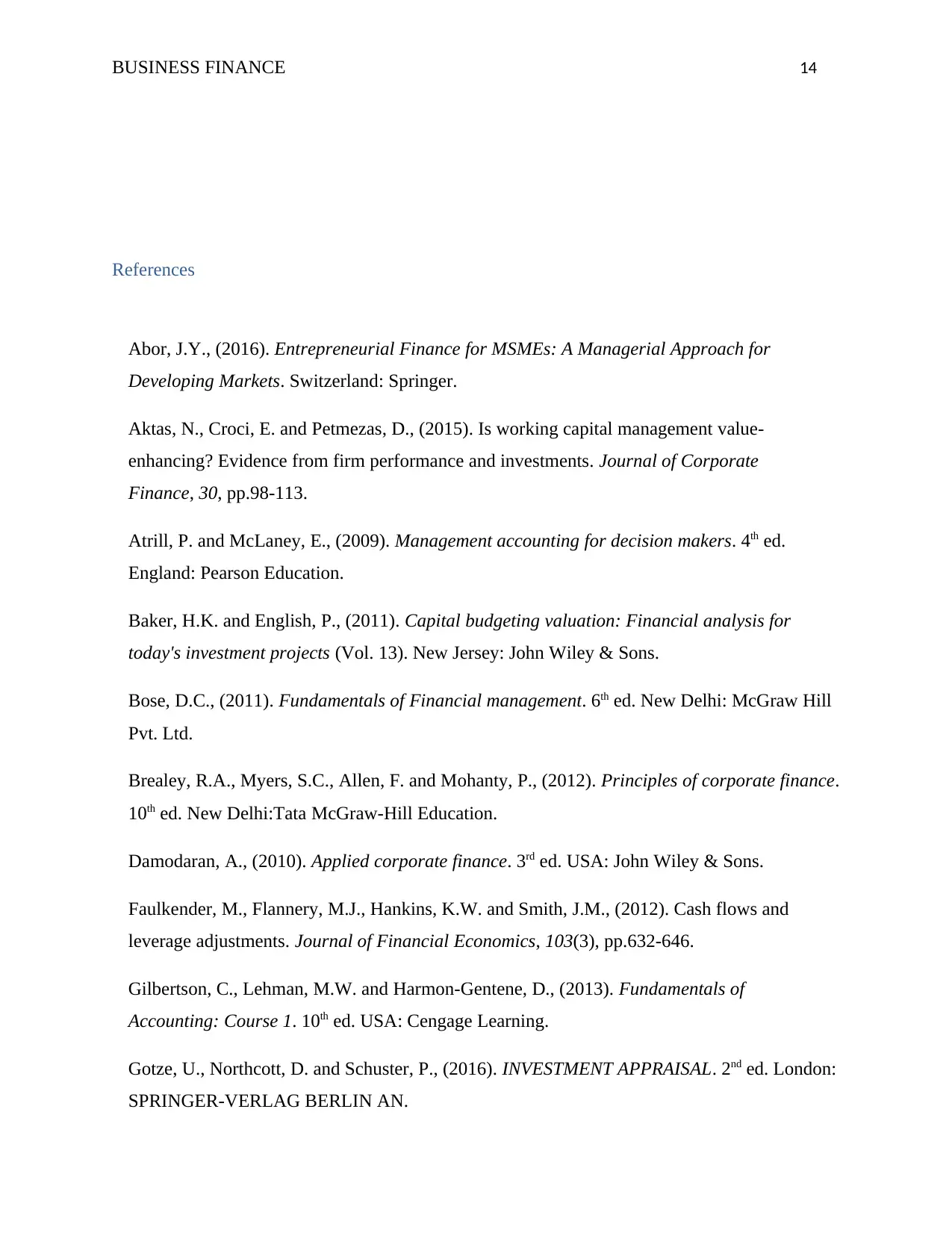
BUSINESS FINANCE 14
References
Abor, J.Y., (2016). Entrepreneurial Finance for MSMEs: A Managerial Approach for
Developing Markets. Switzerland: Springer.
Aktas, N., Croci, E. and Petmezas, D., (2015). Is working capital management value-
enhancing? Evidence from firm performance and investments. Journal of Corporate
Finance, 30, pp.98-113.
Atrill, P. and McLaney, E., (2009). Management accounting for decision makers. 4th ed.
England: Pearson Education.
Baker, H.K. and English, P., (2011). Capital budgeting valuation: Financial analysis for
today's investment projects (Vol. 13). New Jersey: John Wiley & Sons.
Bose, D.C., (2011). Fundamentals of Financial management. 6th ed. New Delhi: McGraw Hill
Pvt. Ltd.
Brealey, R.A., Myers, S.C., Allen, F. and Mohanty, P., (2012). Principles of corporate finance.
10th ed. New Delhi:Tata McGraw-Hill Education.
Damodaran, A., (2010). Applied corporate finance. 3rd ed. USA: John Wiley & Sons.
Faulkender, M., Flannery, M.J., Hankins, K.W. and Smith, J.M., (2012). Cash flows and
leverage adjustments. Journal of Financial Economics, 103(3), pp.632-646.
Gilbertson, C., Lehman, M.W. and Harmon-Gentene, D., (2013). Fundamentals of
Accounting: Course 1. 10th ed. USA: Cengage Learning.
Gotze, U., Northcott, D. and Schuster, P., (2016). INVESTMENT APPRAISAL. 2nd ed. London:
SPRINGER-VERLAG BERLIN AN.
References
Abor, J.Y., (2016). Entrepreneurial Finance for MSMEs: A Managerial Approach for
Developing Markets. Switzerland: Springer.
Aktas, N., Croci, E. and Petmezas, D., (2015). Is working capital management value-
enhancing? Evidence from firm performance and investments. Journal of Corporate
Finance, 30, pp.98-113.
Atrill, P. and McLaney, E., (2009). Management accounting for decision makers. 4th ed.
England: Pearson Education.
Baker, H.K. and English, P., (2011). Capital budgeting valuation: Financial analysis for
today's investment projects (Vol. 13). New Jersey: John Wiley & Sons.
Bose, D.C., (2011). Fundamentals of Financial management. 6th ed. New Delhi: McGraw Hill
Pvt. Ltd.
Brealey, R.A., Myers, S.C., Allen, F. and Mohanty, P., (2012). Principles of corporate finance.
10th ed. New Delhi:Tata McGraw-Hill Education.
Damodaran, A., (2010). Applied corporate finance. 3rd ed. USA: John Wiley & Sons.
Faulkender, M., Flannery, M.J., Hankins, K.W. and Smith, J.M., (2012). Cash flows and
leverage adjustments. Journal of Financial Economics, 103(3), pp.632-646.
Gilbertson, C., Lehman, M.W. and Harmon-Gentene, D., (2013). Fundamentals of
Accounting: Course 1. 10th ed. USA: Cengage Learning.
Gotze, U., Northcott, D. and Schuster, P., (2016). INVESTMENT APPRAISAL. 2nd ed. London:
SPRINGER-VERLAG BERLIN AN.
⊘ This is a preview!⊘
Do you want full access?
Subscribe today to unlock all pages.

Trusted by 1+ million students worldwide
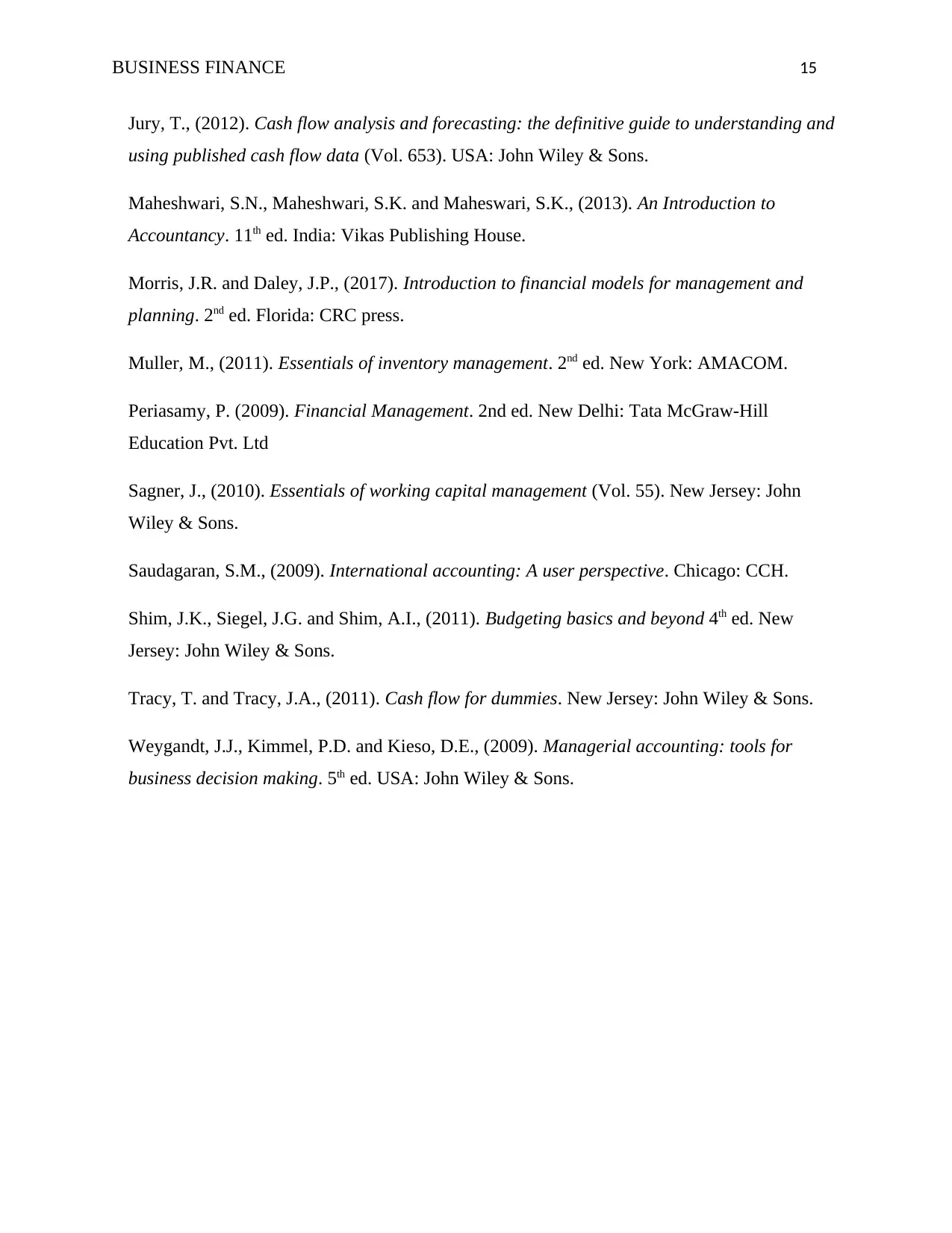
BUSINESS FINANCE 15
Jury, T., (2012). Cash flow analysis and forecasting: the definitive guide to understanding and
using published cash flow data (Vol. 653). USA: John Wiley & Sons.
Maheshwari, S.N., Maheshwari, S.K. and Maheswari, S.K., (2013). An Introduction to
Accountancy. 11th ed. India: Vikas Publishing House.
Morris, J.R. and Daley, J.P., (2017). Introduction to financial models for management and
planning. 2nd ed. Florida: CRC press.
Muller, M., (2011). Essentials of inventory management. 2nd ed. New York: AMACOM.
Periasamy, P. (2009). Financial Management. 2nd ed. New Delhi: Tata McGraw-Hill
Education Pvt. Ltd
Sagner, J., (2010). Essentials of working capital management (Vol. 55). New Jersey: John
Wiley & Sons.
Saudagaran, S.M., (2009). International accounting: A user perspective. Chicago: CCH.
Shim, J.K., Siegel, J.G. and Shim, A.I., (2011). Budgeting basics and beyond 4th ed. New
Jersey: John Wiley & Sons.
Tracy, T. and Tracy, J.A., (2011). Cash flow for dummies. New Jersey: John Wiley & Sons.
Weygandt, J.J., Kimmel, P.D. and Kieso, D.E., (2009). Managerial accounting: tools for
business decision making. 5th ed. USA: John Wiley & Sons.
Jury, T., (2012). Cash flow analysis and forecasting: the definitive guide to understanding and
using published cash flow data (Vol. 653). USA: John Wiley & Sons.
Maheshwari, S.N., Maheshwari, S.K. and Maheswari, S.K., (2013). An Introduction to
Accountancy. 11th ed. India: Vikas Publishing House.
Morris, J.R. and Daley, J.P., (2017). Introduction to financial models for management and
planning. 2nd ed. Florida: CRC press.
Muller, M., (2011). Essentials of inventory management. 2nd ed. New York: AMACOM.
Periasamy, P. (2009). Financial Management. 2nd ed. New Delhi: Tata McGraw-Hill
Education Pvt. Ltd
Sagner, J., (2010). Essentials of working capital management (Vol. 55). New Jersey: John
Wiley & Sons.
Saudagaran, S.M., (2009). International accounting: A user perspective. Chicago: CCH.
Shim, J.K., Siegel, J.G. and Shim, A.I., (2011). Budgeting basics and beyond 4th ed. New
Jersey: John Wiley & Sons.
Tracy, T. and Tracy, J.A., (2011). Cash flow for dummies. New Jersey: John Wiley & Sons.
Weygandt, J.J., Kimmel, P.D. and Kieso, D.E., (2009). Managerial accounting: tools for
business decision making. 5th ed. USA: John Wiley & Sons.
1 out of 16
Related Documents
Your All-in-One AI-Powered Toolkit for Academic Success.
+13062052269
info@desklib.com
Available 24*7 on WhatsApp / Email
![[object Object]](/_next/static/media/star-bottom.7253800d.svg)
Unlock your academic potential
© 2024 | Zucol Services PVT LTD | All rights reserved.





